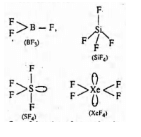Class 11 Exam > Class 11 Questions > Which of the following would have a permanent...
Start Learning for Free
Which of the following would have a permanent dipolemoment? [2005]
- a)SiF4
- b)SF4
- c)XeF4
- d)BF3
Correct answer is option 'B'. Can you explain this answer?
Verified Answer
Which of the following would have a permanent dipolemoment? [2005]a)Si...
SF4 has permanent dipole moment.
SF4 has sp3d hybridization and see saw shape (irregular geometry).
SF4 has sp3d hybridization and see saw shape (irregular geometry).

Whereas XeF4 shows squre planar geometry SiF4 has tetrahedral shape and BF3 has Trigonal planar shape. All these are symmetric molecules. Hence μ ≠ 0.
Most Upvoted Answer
Which of the following would have a permanent dipolemoment? [2005]a)Si...
Out of the given four molecules only SF4 is not symmetrical. As such it will have a permanent dipole moment

Free Test
| FREE | Start Free Test |
Community Answer
Which of the following would have a permanent dipolemoment? [2005]a)Si...
B) SF4
Explanation:
A molecule has a permanent dipole moment if it has polar bonds and an asymmetrical molecular geometry. Let's analyze the given molecules to determine which ones have a permanent dipole moment.
SiF4:
- Si-F bonds are polar due to the electronegativity difference between Si and F.
- However, the molecule has a symmetrical tetrahedral geometry, with the four F atoms arranged around the Si atom.
- The dipole moments of the Si-F bonds cancel each other out due to the symmetrical arrangement.
- Therefore, SiF4 does not have a permanent dipole moment.
SF4:
- S-F bonds are polar due to the electronegativity difference between S and F.
- The molecule has a trigonal bipyramidal geometry, with four F atoms arranged in a plane around the central S atom and one lone pair of electrons.
- The dipole moments of the S-F bonds do not cancel each other out due to the asymmetrical arrangement.
- The lone pair of electrons also contributes to the asymmetry and the overall dipole moment.
- Therefore, SF4 has a permanent dipole moment.
XeF4:
- Xe-F bonds are polar due to the electronegativity difference between Xe and F.
- The molecule has an octahedral geometry, with four F atoms arranged in a plane around the central Xe atom and two lone pairs of electrons.
- The dipole moments of the Xe-F bonds do not cancel each other out due to the asymmetrical arrangement.
- However, the two lone pairs of electrons also contribute to the asymmetry and may overpower the dipole moments of the Xe-F bonds.
- Therefore, XeF4 may or may not have a permanent dipole moment depending on the relative strength of the dipole moments and the lone pairs.
BF3:
- B-F bonds are polar due to the electronegativity difference between B and F.
- The molecule has a trigonal planar geometry, with three F atoms arranged around the central B atom.
- The dipole moments of the B-F bonds cancel each other out due to the symmetrical arrangement.
- Therefore, BF3 does not have a permanent dipole moment.
In conclusion, the molecule SF4 (option B) has a permanent dipole moment due to its polar bonds and asymmetrical molecular geometry.
Explanation:
A molecule has a permanent dipole moment if it has polar bonds and an asymmetrical molecular geometry. Let's analyze the given molecules to determine which ones have a permanent dipole moment.
SiF4:
- Si-F bonds are polar due to the electronegativity difference between Si and F.
- However, the molecule has a symmetrical tetrahedral geometry, with the four F atoms arranged around the Si atom.
- The dipole moments of the Si-F bonds cancel each other out due to the symmetrical arrangement.
- Therefore, SiF4 does not have a permanent dipole moment.
SF4:
- S-F bonds are polar due to the electronegativity difference between S and F.
- The molecule has a trigonal bipyramidal geometry, with four F atoms arranged in a plane around the central S atom and one lone pair of electrons.
- The dipole moments of the S-F bonds do not cancel each other out due to the asymmetrical arrangement.
- The lone pair of electrons also contributes to the asymmetry and the overall dipole moment.
- Therefore, SF4 has a permanent dipole moment.
XeF4:
- Xe-F bonds are polar due to the electronegativity difference between Xe and F.
- The molecule has an octahedral geometry, with four F atoms arranged in a plane around the central Xe atom and two lone pairs of electrons.
- The dipole moments of the Xe-F bonds do not cancel each other out due to the asymmetrical arrangement.
- However, the two lone pairs of electrons also contribute to the asymmetry and may overpower the dipole moments of the Xe-F bonds.
- Therefore, XeF4 may or may not have a permanent dipole moment depending on the relative strength of the dipole moments and the lone pairs.
BF3:
- B-F bonds are polar due to the electronegativity difference between B and F.
- The molecule has a trigonal planar geometry, with three F atoms arranged around the central B atom.
- The dipole moments of the B-F bonds cancel each other out due to the symmetrical arrangement.
- Therefore, BF3 does not have a permanent dipole moment.
In conclusion, the molecule SF4 (option B) has a permanent dipole moment due to its polar bonds and asymmetrical molecular geometry.

|
Explore Courses for Class 11 exam
|

|
Question Description
Which of the following would have a permanent dipolemoment? [2005]a)SiF4b)SF4c)XeF4d)BF3Correct answer is option 'B'. Can you explain this answer? for Class 11 2025 is part of Class 11 preparation. The Question and answers have been prepared according to the Class 11 exam syllabus. Information about Which of the following would have a permanent dipolemoment? [2005]a)SiF4b)SF4c)XeF4d)BF3Correct answer is option 'B'. Can you explain this answer? covers all topics & solutions for Class 11 2025 Exam. Find important definitions, questions, meanings, examples, exercises and tests below for Which of the following would have a permanent dipolemoment? [2005]a)SiF4b)SF4c)XeF4d)BF3Correct answer is option 'B'. Can you explain this answer?.
Which of the following would have a permanent dipolemoment? [2005]a)SiF4b)SF4c)XeF4d)BF3Correct answer is option 'B'. Can you explain this answer? for Class 11 2025 is part of Class 11 preparation. The Question and answers have been prepared according to the Class 11 exam syllabus. Information about Which of the following would have a permanent dipolemoment? [2005]a)SiF4b)SF4c)XeF4d)BF3Correct answer is option 'B'. Can you explain this answer? covers all topics & solutions for Class 11 2025 Exam. Find important definitions, questions, meanings, examples, exercises and tests below for Which of the following would have a permanent dipolemoment? [2005]a)SiF4b)SF4c)XeF4d)BF3Correct answer is option 'B'. Can you explain this answer?.
Solutions for Which of the following would have a permanent dipolemoment? [2005]a)SiF4b)SF4c)XeF4d)BF3Correct answer is option 'B'. Can you explain this answer? in English & in Hindi are available as part of our courses for Class 11.
Download more important topics, notes, lectures and mock test series for Class 11 Exam by signing up for free.
Here you can find the meaning of Which of the following would have a permanent dipolemoment? [2005]a)SiF4b)SF4c)XeF4d)BF3Correct answer is option 'B'. Can you explain this answer? defined & explained in the simplest way possible. Besides giving the explanation of
Which of the following would have a permanent dipolemoment? [2005]a)SiF4b)SF4c)XeF4d)BF3Correct answer is option 'B'. Can you explain this answer?, a detailed solution for Which of the following would have a permanent dipolemoment? [2005]a)SiF4b)SF4c)XeF4d)BF3Correct answer is option 'B'. Can you explain this answer? has been provided alongside types of Which of the following would have a permanent dipolemoment? [2005]a)SiF4b)SF4c)XeF4d)BF3Correct answer is option 'B'. Can you explain this answer? theory, EduRev gives you an
ample number of questions to practice Which of the following would have a permanent dipolemoment? [2005]a)SiF4b)SF4c)XeF4d)BF3Correct answer is option 'B'. Can you explain this answer? tests, examples and also practice Class 11 tests.

|
Explore Courses for Class 11 exam
|

|
Signup for Free!
Signup to see your scores go up within 7 days! Learn & Practice with 1000+ FREE Notes, Videos & Tests.























